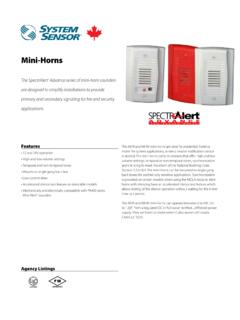Transcription of Epidemiology, Prevalence and Identification of Citrobacter ...
1 International Journal of Scientific and Research Publications, Volume 4, Issue 4, April 2014 1 ISSN 2250-3153 epidemiology , Prevalence and Identification of Citrobacter Species in Clinical Specimens in a Tertiary Care Hospital in India Ritu Nayar*, Indu Shukla**, Asfia Sultan** * Department of Immunoassays & Infectious Serology, Dr. Lal Path Labs Pvt. Ltd., Delhi ** Department of Microbiology, J. N. Medical College & Hospital, Abstract- Citrobacter , a member of the family Enterobacteriaceae, is usually present as intestinal commensal of man and animals. It is well known now that it has been associated with various nosocomial and community acquired infections in humans.
2 This study was conducted in Department of Microbiology, J. N. Medical College and Hospital, Aligarh for a period of one and half years. Isolates were identified as Citrobacter and then till species level using O Hara scheme. They were isolated in an overall Prevalence rate of with Citrobacter koseri and Citrobacter freundii as the most commonly isolated species in laboratory samples. Citrobacter was most commonly isolated from pus & urine in both the sexes with significant predominance in male population. It usually affects people of all age groups including extremes of age predominantly in adolescent and middle age.
3 Index Terms- Citrobacter , Identification , Prevalence , Nosocomial Infections I. INTRODUCTION itrobacter species are considered to be environmental contaminants or harmless inhabitants in intestinal tracts of man and animals. These bacilli are commonly distributed in soil, sewage, water& food. The importance of this species lies in their association with serious nosocomial infections and high degree resistance to common antimicrobial agents used for the treatment of various infections [1,2,3]. Citrobacter freundii, Citrobacter koseri, Citrobacter amalonaticus, Citrobacter farmeri, Citrobacter sedlakii, Citrobacter braakii, Citrobacter werkmanii, Citrobacter youngae, Citrobacter rodenticum, Citrobacter gilleni & Citrobacter murliniae.
4 Citrobacter freundii and Citrobacter koseri have been isolated predominantly as superinfecting agents from urinary and respiratory tract infections. Citrobacter species and Serratia marcescens constituted 1-2% of nosocomial bloodstream, cardiovascular and ear, nose and throat infections [4]. Citrobacter species isolated from the nosocomial urinary tract infections are frequently seen in pure culture (60 to 75%) contrary to the sepsis which is often polymicrobial in nature [5]. Mortality rates are as high as 48 to 50%, death is more often associated with polymicrobic [5] than monomicrobic infections.
5 II. MATERIAL AND METHODS This study was conducted in the Department of Microbiology, J. N. Medical College Hospital, Aligarh, India for a period of one year and six months (2007-2008). It comprised of the samples that were received in the department from outpatient departments, different wards, nurseries, Intensive Care Units (ICUs) and emergency care unit. Various clinical specimens such as urine, pus, cerebrospinal fluid, blood, body fluids including peritoneal,pleural and bile fluids, respiratory tract specimens like bronchial aspirates, tracheal aspirates, bronchoalveolar lavage fluid and ear and nasal swabs, catheter tips and drain tips were received in leak proof sterile containers.
6 Detailed clinical history was also obtained and recorded. Each sample was subjected to standard microbiological techniques for isolation and characterization of Citrobacter on the basis of cultural and biochemical characters [6].The genus Citrobacter was established if the isolate was motile, catalase positive, oxidase negative, lactose non fermenting, Methyl Red positive, VP negative, PPA negative, Citrate positive, ONPG positive Gram-negative Identification to species level was done by applying battery of tests as shown in Figure 1. A total of 105 randomly selected non repetitive bacterial isolates were included in the study.
7 C International Journal of Scientific and Research Publications, Volume 4, Issue 4, April 2014 2 ISSN 2250-3153 Figure 1: Identification Key for Citrobacter Species Ornithine C. freundii C. youngae C. werkmanii C. murlinae C. gillenii C. koseri C. amalonaticus C. farmeri C. braakii C. rodenticum C. sedlakii Malonate C. freundii C. youngae C. murlinae C. werkmanii C. gillenii Malonate Indole C. braakii C. rodenticum C. koseri C. amalonaticus C. farmeri C. sedlakii C. braakii C. rodenticum Malonate Malonate C. amalonaticus C. farmeri C. koseri C. sedlakii Citrate C.
8 Farmeri C. amalonaticus Melibiose C. koseri C. sedlakii Dulcitol C. freundii C. youngae C. murlinae Indole C. youngae C. murlinae Urea C. gillenii C. werkmanii ve +ve ve ve ve +ve +ve +ve ve ve ve ve ve +ve +ve +ve ve +ve +ve +ve International Journal of Scientific and Research Publications, Volume 4, Issue 4, April 2014 3 ISSN 2250-3153 III. RESULTS AND OBSERVATIONS During the study period a total of 24,442 samples were received, among which 526 were identified as Citrobacter spp. The overall Prevalence was Citrobacter spp were isolated in of all isolates of pus followed by blood and urine (Table I).
9 Table I: Prevalence of Citrobacter in Various Clinical Specimens Samples Total no. of isolates Isolates identified as Citrobacter Isolates under study %age Prevalence Pus 6082 356 68 Urine 8023 134 20 Blood 8553 171 8 Others 1784 28 9 Total 24442 526 105 Out of 105 randomly selected isolates were identified as C. koseri, were C. freundii, were C. amalonaticus while constituted other species of Citrobacter . (Table II) Table II: Percentage Distribution of Various Citrobacter Species Species % of strains C. koseri C. freundii C. amalonaticus C. braakii C.
10 Sedlaaki C. youngae C. gilleni C. werkmanii C. murlinae Maximum number of Citrobacter isolates were from 11-20 year age group( ).Only one isolate ( ) was from the age group of >60 years (Figure 2). Citrobacter spp were isolated from of males and of female patients. The male to female ratio was :1. The maximum number of isolates were from pus ( ) followed by urine and blood with and respectively (Table III). 0510152025No. of Specimens0-1011-2021-3031-4041-5051-60>6 0 Age (ye ars)Age Distribution of Citrobacter species Figure 2: Age distribution of Citrobacter species International Journal of Scientific and Research Publications, Volume 4, Issue 4, April 2014 4 ISSN 2250-3153 Table III.















